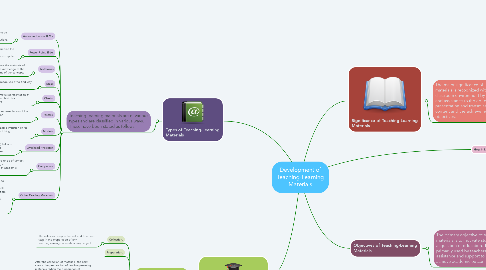
1. Designing and Development of Teaching-Learning Materials
1.1. In the designing and development of teaching-learning materials, there are three major aspects that need to be taken into account.
1.1.1. Collection.
1.1.1.1. The collection step is the first and foremost step in the preparation of any teachinglearning materials or any project
1.1.2. Preparation.
1.1.3. Maintenance.
1.1.3.1. After the collection of materials, the next step is the preparation of teaching-learning materials. When the preparation of teaching-learning materials takes place, then various aspects need to be taken into account.
1.1.3.2. Once the TLMs have been designed and developed, it is vital to maintain them for future use. When one is engaged in the preparation of TLMs, they make use of skills, abilities, financial resources and time. When one feels that TLMs are required to be used in future as well, then the educators even instruct their students to maintain them.
2. Types of Teaching-Learning Materials
2.1. Teaching-learning materials are of various types and are classified in various ways. These have been stated as follows:
2.1.1. Audio and video TLMs.
2.1.1.1. Audio and video TLMs are primarily made use of in schools as well as in higher educational institutions.
2.1.2. Power Point Slide.
2.1.2.1. Slides are effective, as they combine the advantages of OHP slides with the versatility of the computer
2.1.3. Textbooks
2.1.3.1. The textbooks are the methods of imparting basic knowledge to the students in terms of the concepts
2.1.4. Maps
2.1.4.1. Maps are normally made use of to find way to a new place.
2.1.5. Charts.
2.1.5.1. A chart is a diagrammatic representation of a system, process, and historical sequence of the event
2.1.6. Posters.
2.1.6.1. Poster is the symbolic representation of the single idea, concept, or perspective.
2.1.7. Models.
2.1.7.1. Model is the recognizable imitation of real thing (eyes) or abstract thing magnetic.
2.1.8. Overhead Projector.
2.1.8.1. Overhead projector (OHP) helps in displaying visual materials as projection on the screen.
2.1.9. Computers.
2.1.9.1. Computers are regarded to be of utmost significance in acquiring an efficient understanding of academic concepts.
2.1.10. Other Reading Materials.
2.1.10.1. The other reading materials are referred to articles, documents, reports, assignments, projects, newspapers, magazines and books that are used to augment understanding of concepts, as well as generate awareness among individuals regarding various aspects.
3. Help in Longer Retention of Information.
4. Significance of Teaching-Learning Materials
4.1. The major significance of teaching-learning materials is recognized within the classroom environment by providing support and assistance to the educators with the presentation and transmission of educational content and the achievement of educational objectives.
5. Objectives of Teaching-Learning Materials
5.1. The primary objective of teaching-learning materials is to motivate students towards acquisition of education. These are primarily used by teachers to provide assistance and support to the learners to achieve academic outcomes.
5.1.1. Motivate Learners.
5.1.2. Knowledge and Skills among Teachers.
5.1.3. Facilitate Holistic Learning.
5.1.4. Help in Organizing Classroom Teaching.
5.1.5. Promoting Effective Communication.
5.1.6. Practical Applications .
5.1.7. Facilitating Change in Attitudes.
5.1.8. Making Learning Pleasurable.
5.1.9. Concept Formation.
